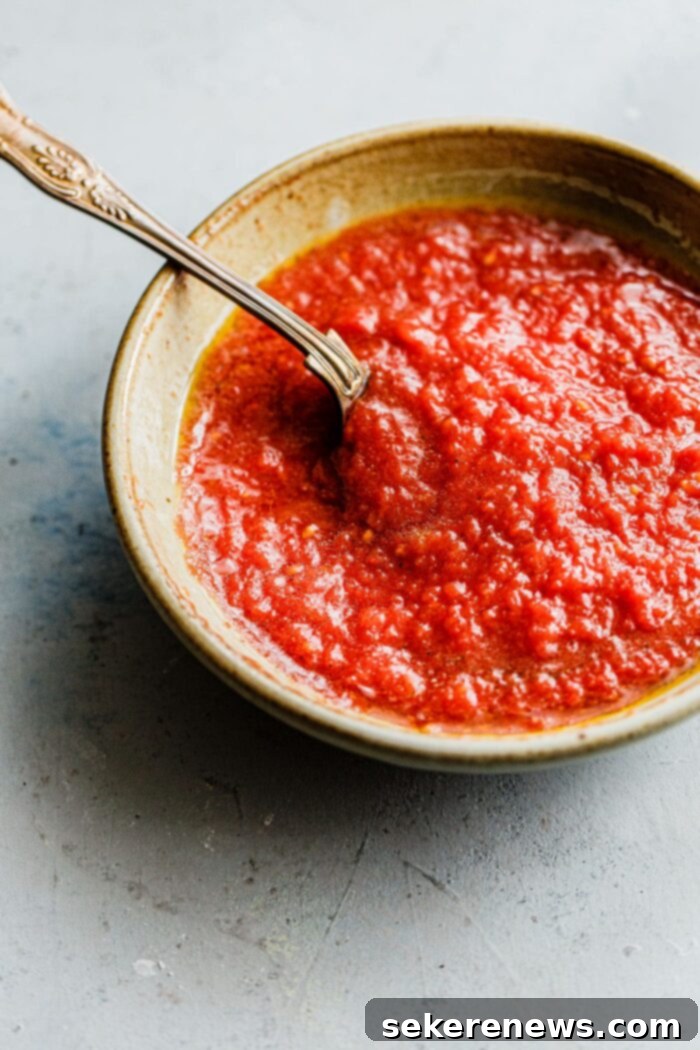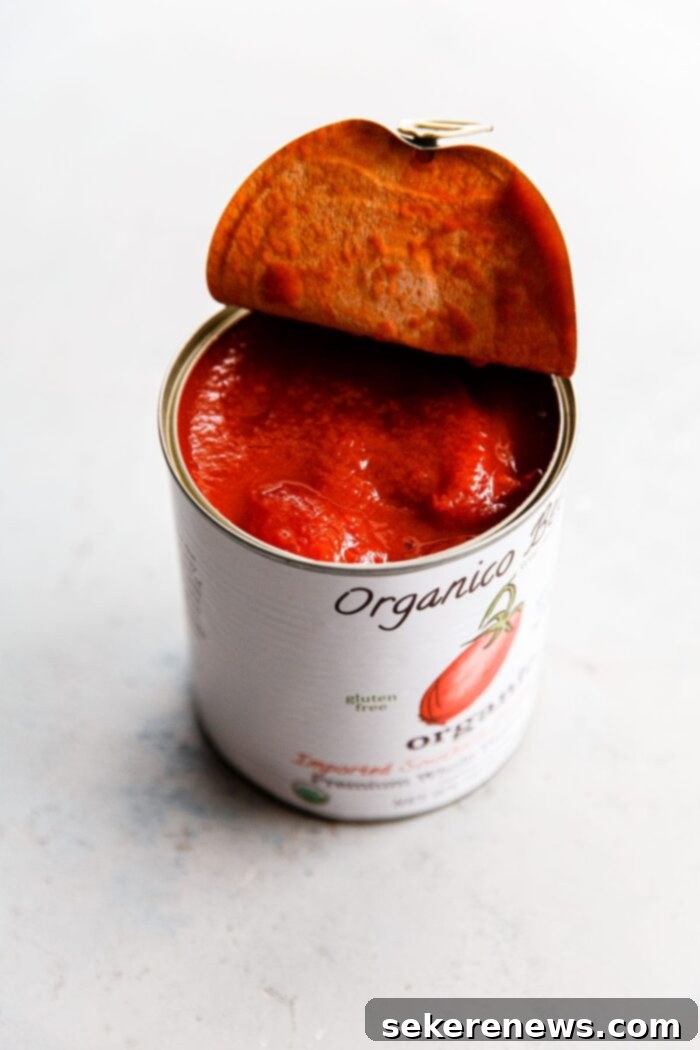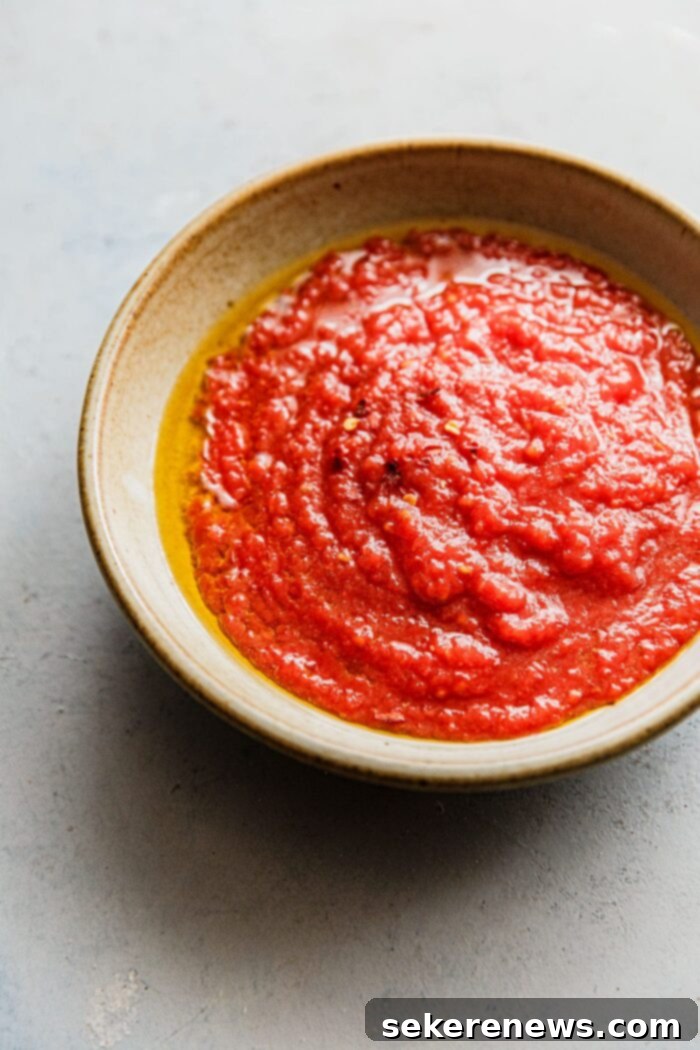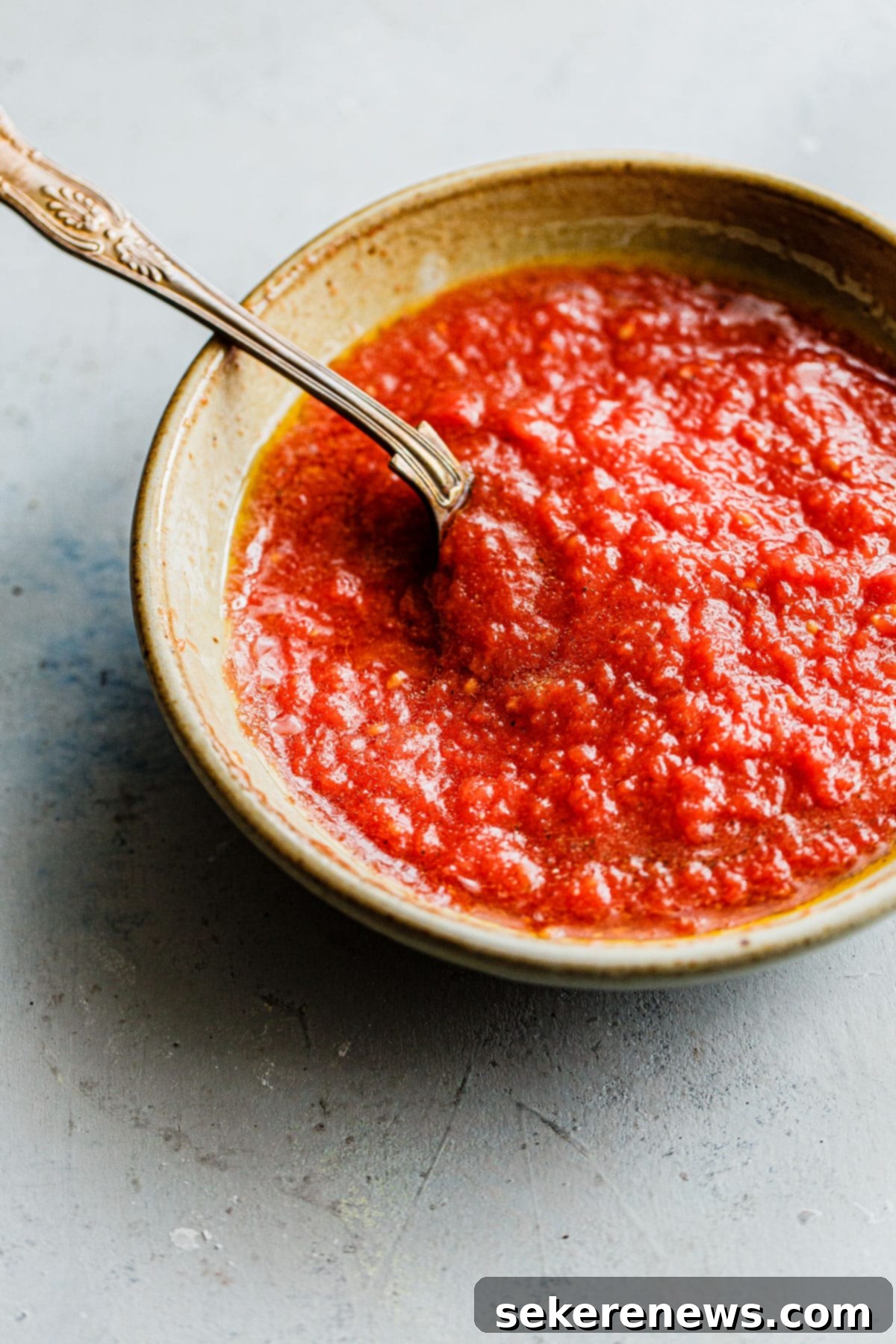The Ultimate Guide to Making the Best Homemade Pizza Sauce (Quick & Easy Recipe)
If you’re looking to elevate your homemade pizza from good to absolutely extraordinary, the secret lies in one crucial component: the sauce. Forget store-bought jars filled with preservatives and artificial flavors. This guide will walk you through crafting the **best homemade pizza sauce** in minutes, using just a handful of everyday pantry staples. It’s a game-changer that will transform your pizza night into an authentic Italian culinary experience.
Our tried-and-true recipe has been perfected over hundreds of pizzas, especially for our sourdough pizza creations. This isn’t just a recipe; it’s your new go-to method for a vibrant, fresh, and perfectly balanced pizza foundation.

The Magic of Homemade Pizza Sauce: Why Bother?
Many home cooks might wonder if making pizza sauce from scratch is truly worth the effort. The answer is a resounding yes! This particular **easy pizza sauce recipe** is not just simple; it’s a revelation. It’s a traditional *uncooked* pizza sauce, meaning you don’t spend hours simmering it on the stove. This method preserves the bright, fresh flavor of the tomatoes, which truly shines once baked on your pizza.
The benefits are immense:
- Superior Flavor: Freshly made sauce offers a depth of flavor and brightness that jarred sauces simply cannot match. You control the balance of sweet, acidic, and savory notes.
- Purity of Ingredients: With only five core ingredients – canned whole peeled Italian tomatoes, extra virgin olive oil, fresh garlic, salt, and pepper – you know exactly what’s going into your body. No added sugars, thickeners, or preservatives.
- Quick & Easy: As the name suggests, this sauce comes together in literal minutes, freeing up your time to focus on your dough or toppings.
- Cost-Effective: Pantry staples are generally affordable, making this a budget-friendly option compared to premium store-bought alternatives.
- Customizable: While perfect as is, this recipe provides an excellent base for personalizing with your favorite herbs and spices.
Whether you’re making a classic Margherita pizza or experimenting with new Neapolitan-style creations, this well-balanced sauce in acidity and seasoning will be the perfect foundation.
Key Ingredients for the Perfect Pizza Sauce
Since this **quick pizza sauce** relies on so few ingredients, the quality of each one is paramount. Investing a little more in good products will yield significantly better results. Here’s a breakdown of what you’ll need and why:
The Star: High-Quality Canned Tomatoes
This is the most critical ingredient. Don’t underestimate the difference good tomatoes make! We specifically use *whole peeled Italian tomatoes*. Why whole peeled? They are generally of higher quality and less processed than crushed or diced varieties. You can easily crush them yourself to the desired consistency, ensuring a fresh texture.
What to look for:
- “San Marzano” Designation (D.O.P.): True San Marzano tomatoes, grown in the Agro Sarnese-Nocerino region of Italy, are famous for their balanced sweet flavor, low acidity, and fewer seeds. Look for the “DOP” (Denominazione d’Origine Protetta) seal.
- Minimal Ingredients: The best cans will simply list “whole peeled tomatoes,” “tomato juice,” and sometimes “basil” or “citric acid.” Avoid cans with added calcium chloride, which can make tomatoes overly firm.
- Trusted Brands: Over the years, countless taste tests have led us to strongly recommend Organico Bello or Bianco DiNapoli brands for their exceptional texture and well-balanced acidity. If these aren’t available at your local store, consider ordering them online – it’s worth the slight extra effort for an authentic taste.

Aromatic Essentials: Fresh Garlic and Olive Oil
- Fresh Garlic: There’s no substitute for fresh garlic. Finely grated garlic (using a microplane) distributes its flavor evenly throughout the sauce without leaving large chunks. It provides a pungent, aromatic kick that defines classic Italian flavors.
- Extra Virgin Olive Oil: A good quality extra virgin olive oil adds richness, a subtle fruity note, and helps to emulsify the sauce slightly, giving it a silky texture. Choose a cold-pressed, quality EVOO for optimal flavor.
Seasoning to Perfection: Salt, Pepper, and Optional Spice
- Kosher Salt: Enhances all the flavors. Always season to taste.
- Freshly Ground Black Pepper: Adds a gentle warmth and aromatic complexity.
- Dried Red Pepper Flakes (Optional): For those who like a little kick, a small pinch of red pepper flakes adds a subtle warmth that complements the tomatoes beautifully.
-

Whole peeled tomatoes being prepared for processing. -

Coarsely pureed tomatoes in a food processor.
How to Make Your Own Pizza Sauce: A Step-by-Step Guide
This **fool-proof pizza sauce** comes together so quickly that you’ll wonder why you ever bought it pre-made. Here’s how to do it:
Step 1: Preparing Your Tomatoes
- Begin by opening your 28-ounce (800g) can of whole peeled Italian tomatoes. Using a slotted spoon, carefully scoop out 5 to 6 whole plum tomatoes from their juices. This should be roughly 290 grams. Transfer these tomatoes to the bowl of a mini food processor.
- Why drain the juices? Draining the canned tomatoes from their excess liquid is key to achieving a slightly thicker, more concentrated pizza sauce. This preferred consistency prevents your pizza from becoming soggy and ensures the sauce flavor is robust.
- Equipment Note: If you don’t own a food processor, don’t worry! You have several options:
- Immersion Blender: Blend directly in a deep bowl or the tomato can itself until coarsely puréed.
- Food Mill: A food mill will give you a wonderfully smooth sauce, free of seeds and skin, which some prefer for a Neapolitan style.
- By Hand: For a rustic texture, simply finely chop the tomatoes with a knife and then crush them further with your hands or a potato masher.
Step 2: Mixing and Seasoning
- Pulse the selected tomatoes in your food processor until they are coarsely puréed. Be careful not to over-process; you want some texture, not a completely smooth paste. This will yield approximately 1¼ cups (10 fluid ounces) of puréed tomatoes.
- Transfer the puréed tomatoes to a clean container or bowl. Now, add the remaining flavor components: 2 teaspoons of extra virgin olive oil, 1 large garlic clove (finely grated with a microplane for even distribution), ½ teaspoon of kosher salt, a generous amount of freshly ground black pepper, and a small pinch of dried red pepper flakes if you desire a hint of heat.
- Stir all the ingredients together thoroughly until well combined. Now comes the most important part: taste and adjust! Add more salt if needed, or a little more pepper or chili flakes to suit your preference. Remember, the flavors will meld further as it sits and cooks on the pizza.
Step 3: Ready for Pizza Night!
- Your homemade pizza sauce is now ready to use immediately! Spread it generously over your favorite pizza dough. This sauce is especially perfect for a classic sourdough pizza, this easier Margherita pizza recipe, or any other tomato-based, Neapolitan-style creation you can dream up.
- This recipe yields enough sauce for three 10-inch or 11-inch pizzas, making it ideal for a family pizza night or when hosting friends.
-

Finely grating fresh garlic directly into the sauce for maximum flavor distribution. -

The freshly grated garlic mingling with the bright red tomato sauce.

Creative Ways to Use Your Delicious Pizza Sauce
This recipe uses only a portion of a standard 28-ounce can of tomatoes, so you’ll likely have leftover whole peeled tomatoes and their juices. Don’t let them go to waste! Here are some fantastic ways to utilize them:
- Simple Pasta Sauce: Combine the leftover tomatoes with their juices, a little more olive oil, garlic, and seasoning. Simmer gently for 20-30 minutes for a quick and flavorful pasta sauce. Excellent with amatriciana or as a base for slow cooker bolognese.
- Hearty Soups and Stews: Whole peeled tomatoes are perfect for adding body and flavor to various dishes. Incorporate them into comforting recipes like red lentil soup, chili, or an easy weekday chickpea curry.
- Future Pizza Creations: If you’re planning another pizza night soon, you can simply save the remaining whole tomatoes in an airtight container in the refrigerator for up to a week.
- Freezing for Later: For longer storage, freeze the leftover tomatoes (whole or lightly crushed) in a freezer-safe bag or container for up to 3 months. This ensures you always have high-quality tomatoes on hand for your next batch of sauce or other recipes.

Elevate Your Sauce: Flavor Variation Ideas
While the classic recipe is perfect, sometimes it’s fun to experiment. Here are a few ways to customize your **DIY pizza sauce**:
- Make It Spicy: For a more intense heat, add more generous pinches of dried red pepper flakes. For a truly gourmet spicy kick, incorporate finely chopped Calabrian peppers in oil – their unique fruity heat is unparalleled.
- New York Style: To achieve that distinctive New York pizzeria flavor, add ½ teaspoon (or more, to taste) of dried oregano to the sauce. You can also experiment with a pinch of dried basil or a touch of onion powder for added depth.
- Sweetness Boost: If your tomatoes are a bit acidic, or if you prefer a slightly sweeter sauce, a tiny pinch (¼ teaspoon) of sugar can balance the flavors without making it overtly sweet.
- Fresh Herb Infusion: Stir in a few fresh basil leaves, torn or roughly chopped, just before using for an extra aromatic touch.
Frequently Asked Questions About Homemade Pizza Sauce
Q: Can I use fresh tomatoes for this recipe?
A: While you *can* use fresh tomatoes, this recipe is specifically designed for high-quality canned whole peeled Italian tomatoes. They offer consistent flavor, texture, and ripeness year-round, which is crucial for an uncooked sauce. If using fresh, choose ripe, meaty varieties like Roma or San Marzano, peel and deseed them, and adjust for acidity/sweetness.
Q: What’s the difference between cooked and uncooked pizza sauce?
A: An uncooked pizza sauce, like this one, relies on the quality of raw ingredients to provide a fresh, bright tomato flavor that develops beautifully during the pizza’s baking process. Cooked sauces, on the other hand, are simmered for a period, often with additional herbs, to develop deeper, richer, and sometimes sweeter flavors. Uncooked sauces are typical for Neapolitan-style pizzas, emphasizing freshness.
Q: How long does homemade pizza sauce last?
A: This homemade pizza sauce, when stored in an airtight container, will last for up to 3-5 days in the refrigerator. Due to the fresh garlic, its flavor will intensify over time, so some prefer to add garlic just before serving if making ahead.
Q: Can I freeze this pizza sauce?
A: Yes! This sauce freezes beautifully. Transfer it to freezer-safe bags or containers, leaving a little headspace for expansion. It can be frozen for up to 3 months. Thaw in the refrigerator overnight before use.
Q: My sauce is too thin/thick. How can I fix it?
A: If your sauce is too thin, it might be due to not draining enough liquid from the canned tomatoes. For future batches, ensure you scoop out the tomatoes more thoroughly. To fix an already thin sauce, you can let it sit uncovered in the fridge for an hour or two, or gently simmer a very small amount on the stovetop to reduce it (though this changes it from uncooked). If it’s too thick, simply stir in a tablespoon or two of the reserved tomato juice from the can until it reaches your desired consistency.

Homemade Pizza Sauce
Pin
Review
SaveSaved!
Equipment
-
Mini Food Processor or Immersion Blender
Ingredients
- 1 (28-ounce; 800 g) can whole peeled Italian tomatoes I highly recommend Organico Bello or Bianco DiNapoli brand for best flavor and texture.
- 2 teaspoons extra virgin olive oil
- 1 large garlic clove finely grated with a microplane
- ½ teaspoon kosher salt or more to taste
- freshly ground black pepper to taste
- pinch dried red pepper flakes optional, for a hint of heat
Instructions
-
Prep Ahead Note: Since this sauce comes together quickly, I prefer to make it just before assembling pizza. It can be prepped ahead, but please note that garlic intensifies in flavor as it sits. If preparing in advance, you might want to use slightly less garlic or add it just before using.
-
Using a slotted spoon, scoop 5 to 6 whole peeled plum tomatoes from their juices – roughly 290 grams – and transfer to the bowl of a mini food processor. Draining the canned tomatoes from their juices helps produce a slightly thicker pizza sauce, which is my preference. After testing various brands of canned tomatoes, I highly recommend Organico Bello or Bianco DiNapoli for superior flavor and texture.
Equipment Note: If you don’t own a food processor, you can use an immersion blender, food mill, or even finely chop and crush the canned tomatoes by hand for a rustic texture.
Storage Note: Leftover tomatoes and their juices can be stored in an airtight container in the refrigerator for up to 5 days or frozen for up to 3 months for future use in sauces, soups, or stews.

-
Pulse the tomatoes until coarsely puréed. You want some texture, not a completely smooth paste. This will yield roughly 1¼ cups (10 fluid ounces) of puréed tomatoes. Transfer the tomatoes to a container or bowl. Add the olive oil, finely grated fresh garlic, kosher salt, freshly ground black pepper, and dried red pepper flakes (if desired). Stir until well combined. Season to taste, adding more salt if needed, to achieve a perfectly balanced flavor profile.

-
Use immediately in your favorite pizza recipes. This vibrant, fresh sauce is ideal for a classic Margherita pizza, any other tomato-based, or authentic Neapolitan-style pizza. This sauce recipe yields enough for three 10-inch or 11-inch pizzas, ensuring a delicious feast for family and friends.

Flavor Variation Ideas:
- Make It Spicy: Add more generous pinches of dried red pepper flakes or, my personal favorite, finely chopped Calabrian peppers in oil.
- New York Style: Add ½ teaspoon or more of dried oregano, and optionally a pinch of onion powder.
- Add Fresh Herbs: Stir in a few fresh basil leaves, torn or roughly chopped, just before using.
- Balance Acidity: A tiny pinch (¼ teaspoon) of sugar can be added if your tomatoes are particularly acidic or if you prefer a slightly sweeter sauce.







